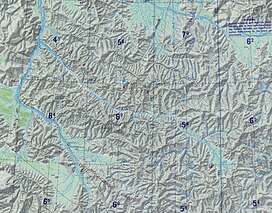Ush-Urekchen
| Ush-Urekchen | |
|---|---|
| Уш-Урэкчэн | |
 Northern ranges of the Kolyma Highlands | |
| Highest point | |
| Peak | Unnamed |
| Elevation | 1,685 m (5,528 ft)[1] |
| Dimensions | |
| Length | 230 km (140 mi) NW/SE |
| Width | 40 km (25 mi) NE/SW |
| Geography | |
Location in theFar Eastern Federal District,Russia | |
| Country | Russia |
| Federal subject | Chukotka Autonomous Okrug, Kamchatka Krai |
| District | Bilibinsky District, Penzhinsky District |
| Range coordinates | 65°30′N162°0′E/ 65.500°N 162.000°E[2] |
| Parent range | Kolyma Highlands, East Siberian System |
| Geology | |
| Orogeny | Alpine orogeny |
| Age of rock | Devonian,Permian,TriassicandJurassic |
| Type of rock | Granite,gabbroandeffusive rock |
| Climbing | |
| Easiest route | FromOmolon |
TheUsh-Urekchen(Russian:уш-урекчен), orUshurakchan(Russian:Ушуракчан),[3]is a mountain range in theChukotka Autonomous OkrugandKamchatka Krai,Far Eastern Federal District,Russia.[4]
The range is composed of granite and gabbro intrusions, breaking through Devonian, Permian, Triassic and Jurassic sediments. There is extensiveeffusive rockcover in certain places.[4]
History
[edit]The Ush-Urekchen was first mapped in the summer of 1870 by topographer P. Afonasiev who was part of the 1868 - 1870 East Siberia expedition of BaronGerhard von Maydell(1835–1894) and astronomerKarl Karlovich Neyman(1830s–1887).[5]About 60 years later, at the time of theUSSR,the range was surveyed in more detail in 1928 by hydrographerIvan Molodykh(1897 - 1939) and in 1932-33 during aerial surveys carried out by geologistSergei Obruchev(1891 - 1965).[6][7]
Geography
[edit]The Ush-Urekchen rises in the northernmost sector of theKolyma HighlandsSystem. The range runs in a roughly northwest / southeast direction for over 230 kilometers (140 mi), between theOloy Rangeto the north and theMolongdin Rangeto the south, roughly parallel to both. TheOmolon Riverlimits the range to the southwest and makes a bend northwards at the western limit of the range. TheOloyriver, a right tributary of the Omolon, limits the range to the north. The eastern end of the range is inKamchatka Krai.
The mountains of the range are slightly pointed, some of them being flat-topped, and have a generally smooth profile, with average elevations between 900 m (3,000 ft) and 1,600 m (5,200 ft). The highest summit is a 1,685 metres (5,528 ft) high unnamed peak located in the central part of the range.[8][4][1]
Many short rivers originate in the range, including tributaries of the Omolon such as theKarbaschan,of theOloy,as well as rivers of thePenzhinabasin in the southeastern area of range.[9][2][1]
Flora
[edit]There are sparse forests on some of the slopes and at the bottom of the valleys of the range up to elevations ranging from 500 m (1,600 ft) to 600 m (2,000 ft). The only vegetation cover at higher altitude ismountain tundra.[4]
See also
[edit]References
[edit]- ^abc"Топографска карта Q-57_58; M 1:1 000 000 - Topographic USSR Chart (in Russian)".Retrieved5 March2022.
- ^abGoogle Earth
- ^Владимир Шумилов,Геологические очерки по Восточной Сибири и Северо-Востоку Российской Федерации,p. 42
- ^abcdуш-урекчен,Great Soviet Encyclopediain 30 vols. / Ch. ed.A.M. Prokhorov– 3rd ed. – M, 1969-1978.(in Russian)
- ^Siberian History - МАЙДЕЛЬ Гергард Людвигович
- ^Молодых, Иван Федорович (1897 - 1939)
- ^В неизведанные края. Путешествия на Север 1917 – 1930 г.г.
- ^National Atlas of Russia - Chukotka
- ^1,000,000 scale Operational Navigation Chart; Sheet C-7


